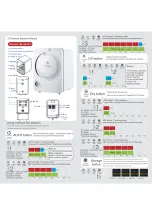
3
Instrument Overview
ISQ EC and ISQ EM Mass Spectrometer Operating Manual
Page 41
3.2
Overview of an LC/MS or IC/MS Analysis
In a typical LC/MS or IC/MS analysis, the liquid chromatograph (LC) or ion
chromatograph (IC) portion of the system separates a mixture into its
chemical components. The LC/IC pump produces a solvent stream (the
mobile phase) that passes through an LC/IC column (containing the
stationary phase) under high pressure. An autosampler introduces a
measured quantity of sample into this solvent stream.
As the solvent stream passes through the LC/IC column, the sample
separates into its chemical components. The rate at which the components
of the sample elute from the column depends on their relative affinities to
the mobile phase and the solid particles that make up the column packing.
As the separated chemical components exit the LC/IC column, they enter
the mass spectrometer for ionization and analysis. As the mass
spectrometer analyzes the ionized components and determines each mass-
to-charge ratio (m/z) and relative intensity, it sends a data stream to the
data system computer. When the system setup includes a syringe pump and
divert/inject valve, there are three additional ways to introduce a sample
into the mass spectrometer, as described in Table 1.
Method
Description
Direct infusion
Connect a syringe pump directly to the atmospheric pressure
ionization (API) source of the mass spectrometer.
High-flow
infusion
Use a union tee to combine the flow from a syringe pump with the
flow from an LC or IC pump.
Manual loop
injection
Connect a sample loop, a needle port fitting, and an LC/IC pump to
an external divert/inject valve. After you fill the sample loop with
sample, switch the position of the divert/inject valve, which places
the contents of the sample loop in the path of the solvent flow
produced by the LC or IC pump.
Table 1: Methods of sample introduction into the mass spectrometer
The ISQ EC and ISQ EM Single Quadrupole Mass Spectrometers consist of an
atmospheric pressure ion (API) source, ion optics, a single-stage mass
analyzer, and an ion detection system. The ion optics, mass analyzer, ion
detection system, and part of the API source are enclosed in a vacuum
manifold. Ionization of the sample takes place in the API source. The specific
method used to ionize the sample is referred to as the ionization technique.
The ion optics transmit the ions produced in the API source into the mass
analyzer to determine the mass-to-charge ratio (m/z) (of the ions produced
in the API source). The polarity of the electric potentials applied to the API
source and ion optics determines whether positively charged ions or
Summary of Contents for ISQ EC
Page 1: ...ISQ EC and ISQ EM Mass Spectrometer Operating Manual 1R120591 0002 Revision E February 2019 ...
Page 4: ...Page 4 ISQ EC and ISQ EM Mass Spectrometer Operating Manual ...
Page 66: ...5 Installation Page 66 ISQ EC and ISQ EM Mass Spectrometer Operating Manual ...
Page 135: ...6 Operation ISQ EC and ISQ EM Mass Spectrometer Operating Manual Page 135 ...
Page 204: ...7 Maintenance and Service Page 204 ISQ EC and ISQ EM Mass Spectrometer Operating Manual ...
Page 228: ...12 Index Page 228 ISQ EC and ISQ EM Mass Spectrometer Operating Manual 12 Index ...
Page 229: ...12 Index ISQ EC and ISQ EM Mass Spectrometer Operating Manual Page 229 ...
















































